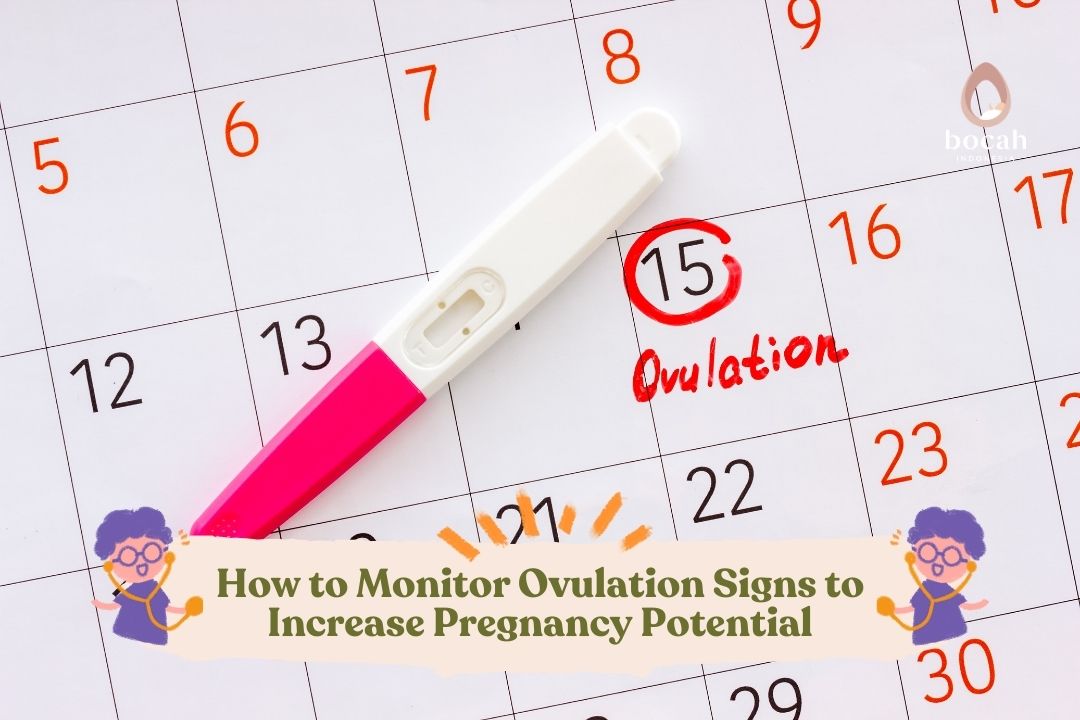How to Monitor Ovulation Signs to Increase Pregnancy Potential

There are several effective ways to monitor ovulation signs to help increase pregnancy potential. Check out the tips in this review.
Ovulation period aka fertile period is important to know for mums who are planning a pregnancy. Ovulation is the process when a mature egg is released from the ovary. The egg then travels to the fallopian tube where it can be fertilised by a sperm cell.
Ovulation is the best time for sexual intercourse so as to increase your pregnancy potential. By effectively monitoring the signs of ovulation, you can increase your chances of having a baby while undergoing a pregnancy programme.
When Does Ovulation Happen?
Normally, the menstrual cycle occurs in the range of 24-35 days. If you have a regular menstrual cycle, the fertile period usually takes place about 14 days before your period starts.
Normally, the menstrual cycle occurs in the range of 24-35 days.
Tanya Mincah tentang Promil?
This varies from woman to woman. If you have a 35-day menstrual cycle, then you might ovulate around day 21.
You can also use a menstrual calendar to find out your fertile period. You can do this by estimating the time of your next menstrual period, then count back about 12 days before the date of your period, then that day is estimated as your fertile period.
While, according to The American College of Obstetricians and Gynaecologists (ACOG), ovulation is likely to occur about 5 days before or 1 day after the estimated fertile window.
Unfortunately, menstrual calendars and estimated fertile days are difficult to apply if you have an irregular menstrual cycle. Irregular menstrual cycles can be caused by many factors, such as lack of sleep, severe stress, excessive exercise, eating disorders, and PCOS. Therefore, a follow-up examination is needed to determine your fertile period.
Effective Ways to Monitor Ovulation Signs
Evulation signs are different for every woman. However, there are a number of ways to effectively monitor the signs of ovulation that you can try, here are some of them:
-
Basal body temperature
Basal temperature is the body temperature when you are resting. Basal temperature will increase when you are in your fertile period. To measure the basal body temperature, you need to use a special thermometer that has a feature to check the basal body temperature (BBT).
Basal Body Temperature (BBT). Normally, when not in the fertile period, Mother’s body temperature is around 36.5 & 37.4 & deg;C. However, when ovulation occurs, your body temperature will increase by about 0.3 –0.5 °C from normal body temperature. The increase in the hormone progesterone which plays an important role in the female reproductive system is the cause. To get accurate results, take basal body temperature measurements every day during the full menstrual cycle. You can check from the first day of your period to the first day of your next period.
-
Cervical mucus
The next effective way to monitor signs of ovulation is by checking the condition of cervical mucus. During the fertile period, cervical mucus is slippery, thin and clear in colour.
Cervical mucus looks similar to egg white. This is due to the influence of the hormone progesterone which regulates ovulation. The thin shape of cervical mucus allows sperm to pass through the cervix during sexual intercourse. Cervical mucus helps sperm survive in a more alkaline environment, increasing the chances of pregnancy.
Mothers can check the condition of the cervical mucus several times a day using a cleanly washed finger or tissue. If there is no cervical mucus around the vagina, it means that you are not ovulating. Unfortunately, cervical mucus is difficult to use to check the fertile period in women who have vaginal discharge or use feminine hygiene products.
-
Ovulation test pack
Fertile period signs can also be found by dripping urine into an ovulation test pack. It will show changes in the Luteinizing Hormone (LH) in the urine. An increase in LH indicates that mum will ovulate within 12-36 hours. To obtain accurate results, ovulation test pack should be used for several consecutive days. During the fertile period, have regular sexual intercourse.
The accuracy rate of fertile days can increase by about 95% if used for 10 consecutive days. Although very accurate, unfortunately the ovulation test pack ovulation test pack is said to be expensive.
-
Pain in abdominal area
Abdominal pain can be a sign that you are fertile. According to Pacific Fertility Center Los Angeles, it is estimated that around 20 per cent of women experience abdominal pain when ovulating.
The pain usually appears in the lower abdomen, precisely on the ovaries. In addition, pain can also be felt in one of the backs.
Increase Chances of Ovulation This Way
Monitoring ovulation signs will be more effective if balanced with a healthy lifestyle that can increase fertility. Here are some tips that mums can do to increase their chances of pregnancy:
-
Maintain ideal body weight
Excess or lack of weight can inhibit the release of eggs, aka ovulation. As a result, you may have irregular menstrual cycles. Therefore, maintain your ideal weight!
-
Prevent sexually transmitted infections
Sexually transmitted infections (STIs) can cause difficulty conceiving. Examples of STIs that can interfere with pregnancy potential are chlamydia and gonorrhoea. To prevent STIs, mums and dads should only have sex with their partner.
-
Avoid work shift nights
Frequent work & shift nights can affect your hormone levels. This can increase the risk of infertility. If you work the night shift, try to get enough sleep when you’re not working.shift night, try to get enough sleep when you’re not working.
That’s a list of effective ways to monitor ovulation signs that you can apply. Consult your doctor if you have any further questions about fertility and pregnancy preparation.
To find out more information about pregnancy preparation, check out articles on Bocah Indonesia.
This article has been medically reviewed by Dr. Chitra Fatimah.
Source:
- Richard E. Jones PhD, Kristin H. Lopez PhD. Human Reproductive Biology (Fourth Edition). 2014.
- Health Direct. Fever. 2023.
- Pacific Fertility Center Los Angeles. Five Tips for Tracking Ovulation. 2018.
- Krissi Danielsson. Verywell Family. How to Track Ovulation When Trying to Conceive. 2022
- Nicole Galan, RN. Healthline. How to Increase Your Chances of Getting Pregnant. 2023
- Mayo Clinic. Female fertility: Why lifestyle choices count











One Response
Have lent alot thanks for the information